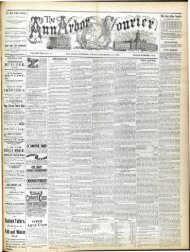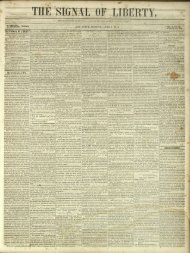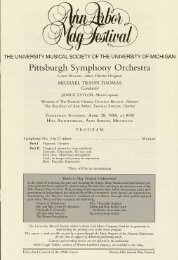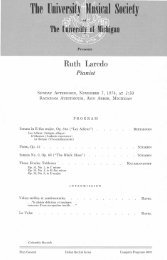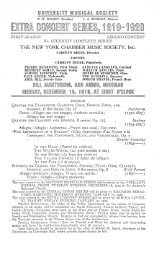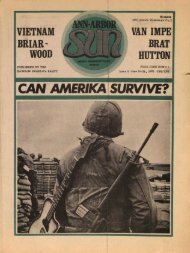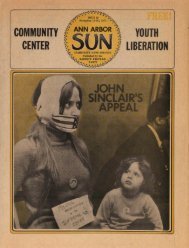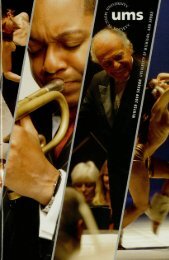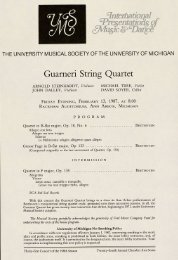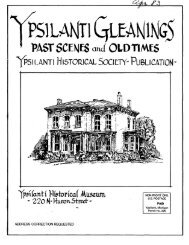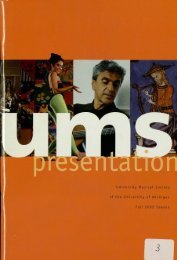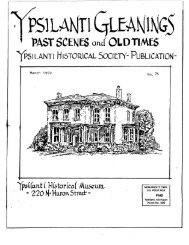Bill T. Jones (Artistic Director/Co-Founder - Ann Arbor District Library
Bill T. Jones (Artistic Director/Co-Founder - Ann Arbor District Library
Bill T. Jones (Artistic Director/Co-Founder - Ann Arbor District Library
You also want an ePaper? Increase the reach of your titles
YUMPU automatically turns print PDFs into web optimized ePapers that Google loves.
ecent Flute <strong>Co</strong>ncerto, like his Piano <strong>Co</strong>ncerto,<br />
which the Chicago Symphony played four years<br />
ago, is a prime example of Dalbavie's unique brand<br />
of modernism, steeped in the concerns that have<br />
preoccupied composers for centuries yet expressed<br />
in a language that would have been unrecognizable<br />
only a few years ago.<br />
Dalbavie's training is defined by avant-garde big<br />
names and cutting-edge trends. His composer's<br />
voice was initially influenced by "spectralism" a<br />
compositional style of the 1970s and 1980s<br />
that is based on a rigorous, computer-derived<br />
exploration of timbre (the color of sound) and<br />
then at the technology-based world of IRCAM,<br />
the music research temple in Paris launched by<br />
Pierre Boulez. He also worked with John Cage and<br />
Merce Cunningham in London in 1980, with Italian<br />
pioneer Franco Donatoni in Sienna four years later,<br />
and he studied orchestral conducting with Boulez<br />
in the late 1980s.<br />
Beginning with his earliest works, Dalbavie<br />
became known for writing music that explores color<br />
and texture. His scores are often characterized by<br />
a complex layering of foreground and background,<br />
like several stories all unfolding simultaneously. (He<br />
once compared the technique not to Proust, who<br />
moves back and forth between past and present,<br />
but to the American soap opera Dallas, which had<br />
obviously infiltrated French television at the time.)<br />
He also is fascinated by sound and acoustics<br />
and in the way music relates to the performance<br />
space. His first concerto, for violin, composed<br />
in 1996 Dalbavie's first composition without<br />
electronics planted individual members of the<br />
orchestra within the audience. "The idea," he said at<br />
the time, "was to take a very conventional form and<br />
put it into space, destabilize the form." <strong>Co</strong>ncertate<br />
II suono (which was commissioned by the Chicago<br />
Symphony and the Cleveland Orchestra to honor<br />
Boulez's 75th birthday) carried the idea further,<br />
placing chamber groups of instruments throughout<br />
the concert hall. Dalbavie has compared the idea<br />
to seeing Mantegna's celebrated fresco Camera<br />
degli Sposi (The bridal chamber) in Mantua, which<br />
covers not only the walls, but the ceiling as well:<br />
"You're in the painting," he has said.<br />
But beginning with <strong>Co</strong>lor in 2002, Dalbavie<br />
moved away from composing these spatial works<br />
to concentrate on pieces that investigate sonority<br />
and texture from the confines of the conventional<br />
orchestral stage and to refine his ideas of musical<br />
"development." In Dalbavie's recent scores,<br />
UMS Chicago Symphony Orchestra<br />
including the Piano <strong>Co</strong>ncerto performed in Chicago<br />
in 2006 (with Leif Ove Andsnes, its dedicatee, as<br />
the soloist), the music is in a constant state of<br />
transformation of one sound or one idea evolving<br />
into another.<br />
Dalbavie's standard composing method<br />
literally behind closed doors is very much his<br />
own. "I have the piece finished before I write," he<br />
told The New York Times a few years ago:<br />
Of course, the detail changes as I work. But I<br />
am the contrary of Boulez in that, because he<br />
starts with a little motif and sees what he can<br />
make of it, and the motif grows, like a plant.<br />
With me the piece arrives like a block, after<br />
a certain time. I'm a little like the Japanese<br />
painter who would spend months waiting and<br />
then do a picture in three seconds. Of course,<br />
in music three seconds is not possible. You have<br />
months of work to do. But still, I don't discover<br />
the piece progressively. Suddenly it's there.<br />
While writing his Piano <strong>Co</strong>ncerto five years<br />
ago composed after extensive study of the most<br />
famous piano concertos of the past Dalbavie<br />
formed strong ideas about the relationship between<br />
the solo instrument and the orchestra. In the end, it<br />
was the traditional "classical confrontation," as he<br />
put it, that he chose to avoid. The Flute <strong>Co</strong>ncerto<br />
is a further exploration of the idea that the two<br />
do not so much face off or argue, as in many of<br />
the most dramatic concertos in the repertory, but<br />
coexist in an ever-changing world. The flute and<br />
orchestra begin and end playing together, and in<br />
between there is constant interaction.<br />
Dalbavie's fascination with color still runs deep<br />
throughout this work, reflecting his earlier stance<br />
as a "spectralist" (he told The New York Times<br />
that "spectralist" composers work like Monet,<br />
who broke down colors into components. "We<br />
de-compose sound and then redeploy it," he<br />
said). The Flute <strong>Co</strong>ncerto, like much of Dalbavie's<br />
more recent work, also shows an occasional<br />
unexpected affinity with certain elements of so-<br />
called minimalism the gradually shifting patterns,<br />
the sense of stasis. And, after years of focusing on<br />
color and harmony, Dalbavie has begun to turn his<br />
attention to melody "I started with vertical music<br />
and I have moved progressively towards horizontal<br />
music," is how he has put it. (A new chamber<br />
work, Melodia, which Dalbavie has described as a<br />
"symbol of my evolution," was premiered in New<br />
York in December.)




